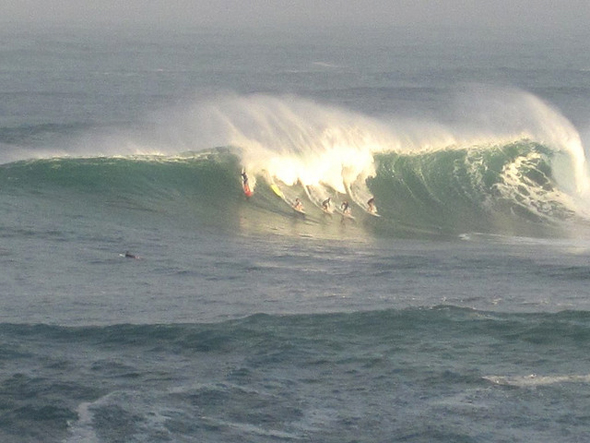EDDIE AIKAU – THE MAN BEHIND THE NAME

*Photo Credit: Dan Zelikman
In Hawaii the name Eddie Aikau is as famous as Waimea Bay, the celebrated Oahu surf break where the prestigious big-wave surf contest carrying his name is held each year. Wherever you go — whether you’re passing a bumper sticker along Pali Highway or grabbing breakfast from Rainbow Drive Inn you’ll hear his name and see the phrase “Eddie would go.”
Synonymous with surfing and Hawaii as well as bravery and honor, Hawaiian waterman Edward Ryon Makuahanai Aikau lived a life on the water as a skilled lifeguard and surfer.
His Hanabata Days
Born May 4, 1946 in Kahului, Maui, Aikau grew up the third child of parents Solomon and Henrietta Aikau. The young Aikau family did not have a lot and lived in a compound of 15 houses off a dirt road. But on the weekends, his father would take the keiki (children) to Kahului Harbor to surf on redwood boards in the harbor’s shore break. Aikau’s family moved to Oahu at the age of 13 and a few years later Aikau left school to work at the Dole pineapple cannery.
On Oahu, the Aikau kids started surfing the long rolling waves of Waikiki with plywood boards they crafted themselves. Aikau got his feet wet riding big waves, with legends the likes of John Kelly and Sammy Lee at giant Sunset in 1967. Later that year, Aikau paddled out on one of Waimea Bay’s biggest days rubbing shoulders and dominating the line up amongst big wave superstars Greg Noll and George Downing. A photo of Aikau from that day made it into Lifemagazine and Aikau rode into surfing stardom.
In 1968 Aikau was able to put his love for the water to work, becoming the first lifeguard hired by the City & County of Honolulu to work at Waimea Bay on Oahu. In this position he had the seemingly insurmountable job of patrolling the waters from Sunset to Haleiwa, but despite this vast area of responsibility not a single life was lost while he was on watch. As a result, just three years later, he was honored as Lifeguard of the Year.
On his off hours, he became famous for taking on Hawaii’s big North Shore surf, and won several awards including the prestigious Duke Kahanamoku Invitational Surfing Championship in 1977.
Eddie Would Go
In 1978 Aikau volunteered as a member of the Polynesian Voyaging Society’s crew as the group attempted to replicate a previous 1976 journey to Tahiti. Through the Hokulea, an authentic replica of ancient Polynesian canoes, the Polynesian Voyaging Society hoped to inspire a renaissance of Polynesian voyaging techniques and revitalize the Hawaiian and Polynesian cultures through seafaring without any modern technology.
Shortly after pushing off from Magic Island for the 2,500-mile voyage, the double-hulled canoe, Hokulea, capsized off of Molokai. After hours hanging onto the boat hoping to be rescued, Aikau insisted on paddling off towards Lanai on his surfboard to get help.
Hours later a plane saw the boat’s flares and the Hokulea crew was rescued that same day by the US Coast Guard. A search — the largest air-sea search in Hawaii’s history — was launched but Aikau was never heard from or seen again.

*Photo Credit: Dan Zelikman
Making (Big) Waves
In his honor of Aikau’s love for chasing giant surf, popular surf brand Quiksilver, holds an annual big-wave contest each year dubbed “The Eddie” or more formally, the Quiksilver Big Wave Invitational in Memory of Eddie Aikau.
The contest’s unique format, establishes it as the preeminent big wave invitational, and since it was first held in 1985 more than 30 years ago, has run just eight times. Radical tournament rules require that wave heights reach a minimum of 20 feet “Hawaiian style” (which measures the back of the wave) or 30 to 50 feet by conventional measurements.
First held at Oahu’s Sunset Beach, the term “Eddie would go” was born when wave heights and conditions reached dangerous levels. Contest officials discussed canceling the Eddie, but celebrated surfer Mark Foo encouraged the contest to go forward, saying “Eddie would go.” The phrase stuck and has been a mantra for the contest — and a well-known term of encouragement throughout the Hawaiian Islands — ever since.
The tournament later moved to Waimea Bay in 1987 where it was won by Aikau’s younger brother, Clyde Aikau.
The contest invites 28 riders, known for their big wave skill, and is held over two rounds without the use of jet skis or any other towing devices. The four best scoring waves over the two rounds, make up a surfers total score.
Past winners include Denton Miyamura (1984/1985), Clyde Aikau (1986/1987), Keone Downing (1989/1990), Noah Johnson (1998/1999), Ross Clarke-Jones (2000/2001), Kelly Slater (2001/2002) and Bruce Irons (2004/2005). Most recently, California resident Greg Long took home the title and $55,000 purse when the contest was held on Dec. 9, 2009. Long’s scores — including a perfect 100-point wave — were particularly impressive, considering he first rode Waimea that same week.
Regardless of whether the contest runs or not, each year an opening ceremony and Hawaiian blessing is held the first Thursday of December. The holding period for the Eddie runs during Hawaii’s big North Shore season, from Dec. 1 through the end of February. Should the surf gods align (as determined by hordes of oceanographers, meteorologists and big wave surf experts — and most importantly, Eddie contest director, George Downing) the 28 competitors receive the official call and — along with visitors and media from around the world, descend onto Waimea Bay to watch the surfers go… like Eddie would have.
